Global Social Issues & Corporate Responsibility
VerifiedAdded on 2020/05/16
|6
|1798
|92
AI Summary
This assignment analyzes several videos addressing global social issues, including poverty, environmental sustainability, and labor practices within multinational corporations. It requires examining how companies like Cotton On and Walmart address these challenges, focusing on ethical dilemmas, transparency, and the consequences of globalization. The analysis should consider various stakeholders involved and the broader implications for society.
Contribute Materials
Your contribution can guide someone’s learning journey. Share your
documents today.
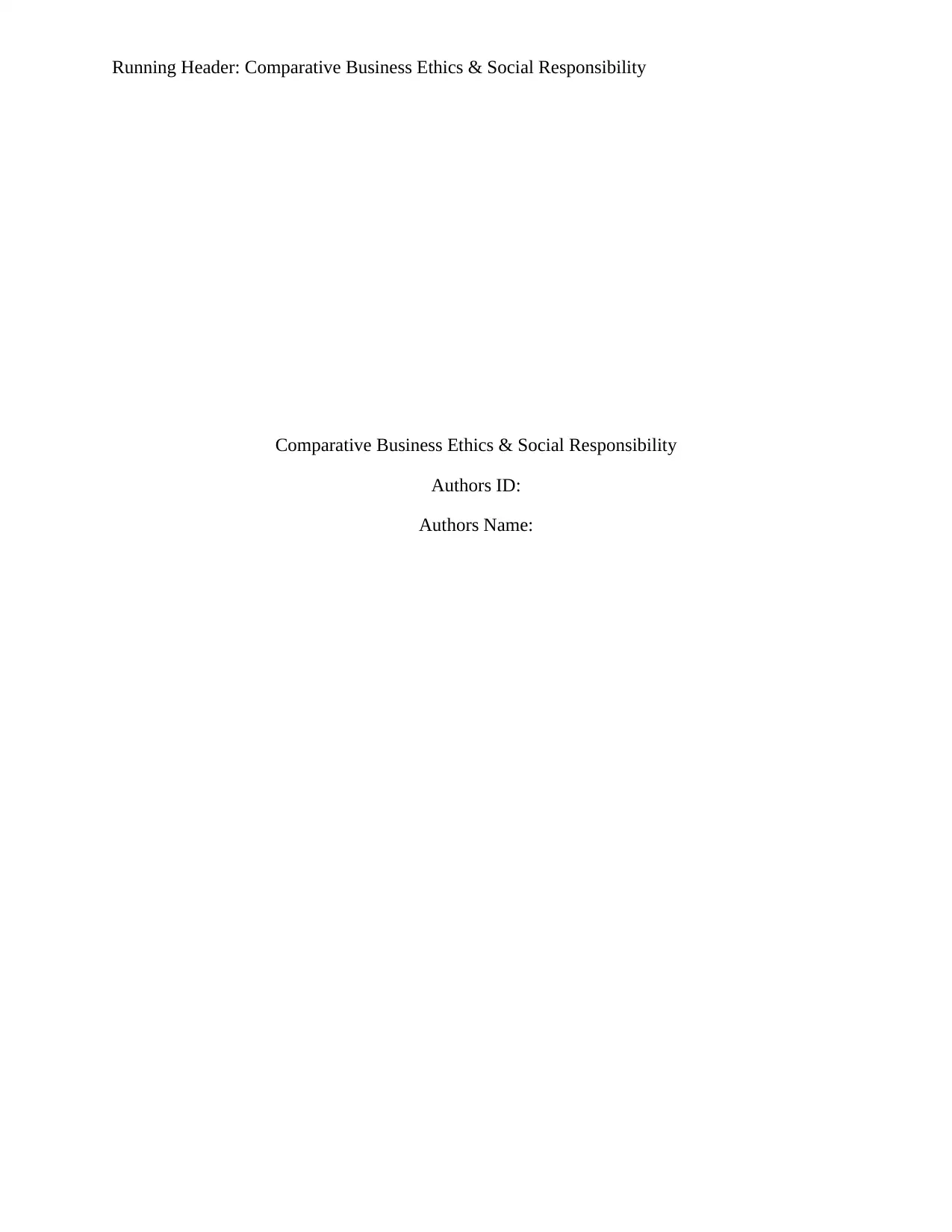
Running Header: Comparative Business Ethics & Social Responsibility
Comparative Business Ethics & Social Responsibility
Authors ID:
Authors Name:
Comparative Business Ethics & Social Responsibility
Authors ID:
Authors Name:
Secure Best Marks with AI Grader
Need help grading? Try our AI Grader for instant feedback on your assignments.
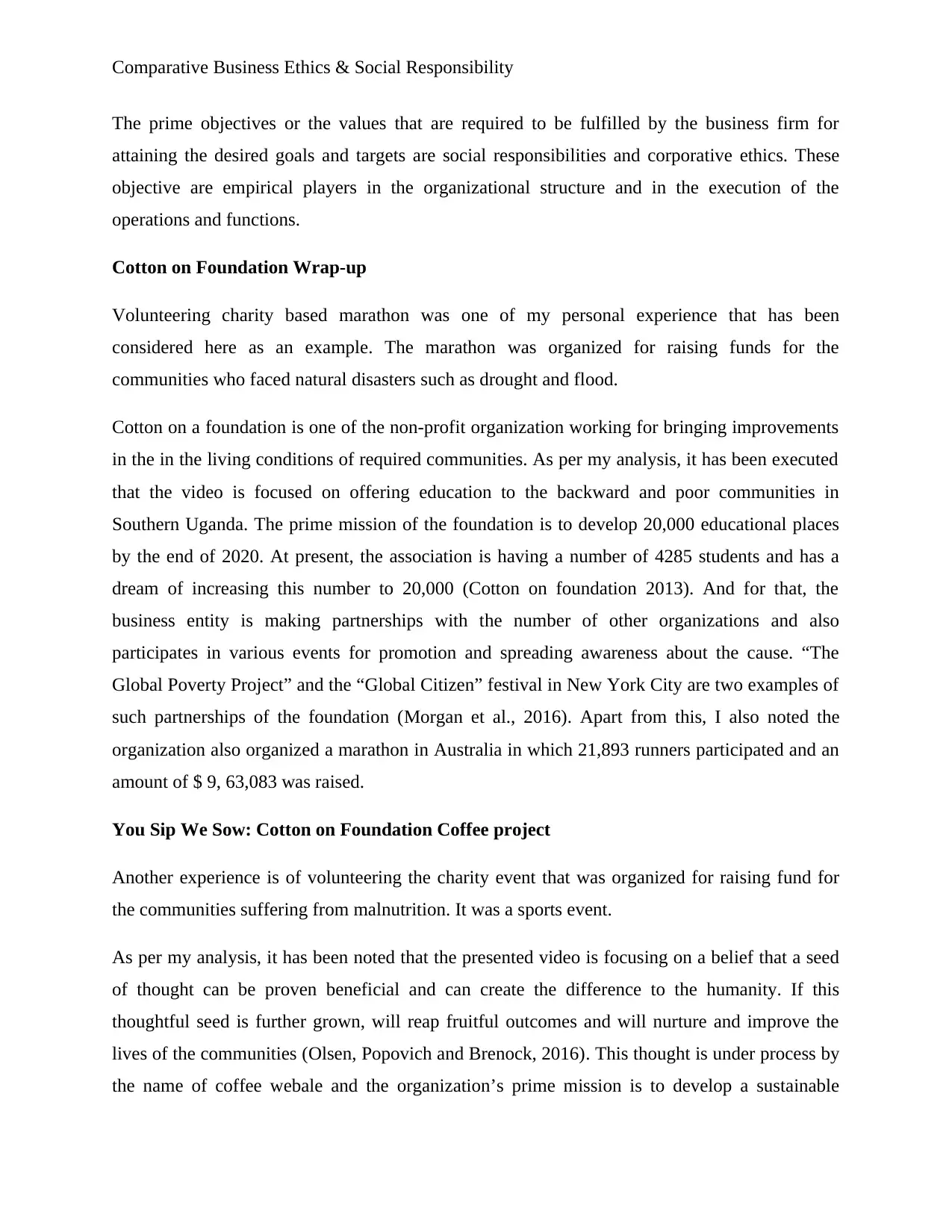
Comparative Business Ethics & Social Responsibility
The prime objectives or the values that are required to be fulfilled by the business firm for
attaining the desired goals and targets are social responsibilities and corporative ethics. These
objective are empirical players in the organizational structure and in the execution of the
operations and functions.
Cotton on Foundation Wrap-up
Volunteering charity based marathon was one of my personal experience that has been
considered here as an example. The marathon was organized for raising funds for the
communities who faced natural disasters such as drought and flood.
Cotton on a foundation is one of the non-profit organization working for bringing improvements
in the in the living conditions of required communities. As per my analysis, it has been executed
that the video is focused on offering education to the backward and poor communities in
Southern Uganda. The prime mission of the foundation is to develop 20,000 educational places
by the end of 2020. At present, the association is having a number of 4285 students and has a
dream of increasing this number to 20,000 (Cotton on foundation 2013). And for that, the
business entity is making partnerships with the number of other organizations and also
participates in various events for promotion and spreading awareness about the cause. “The
Global Poverty Project” and the “Global Citizen” festival in New York City are two examples of
such partnerships of the foundation (Morgan et al., 2016). Apart from this, I also noted the
organization also organized a marathon in Australia in which 21,893 runners participated and an
amount of $ 9, 63,083 was raised.
You Sip We Sow: Cotton on Foundation Coffee project
Another experience is of volunteering the charity event that was organized for raising fund for
the communities suffering from malnutrition. It was a sports event.
As per my analysis, it has been noted that the presented video is focusing on a belief that a seed
of thought can be proven beneficial and can create the difference to the humanity. If this
thoughtful seed is further grown, will reap fruitful outcomes and will nurture and improve the
lives of the communities (Olsen, Popovich and Brenock, 2016). This thought is under process by
the name of coffee webale and the organization’s prime mission is to develop a sustainable
The prime objectives or the values that are required to be fulfilled by the business firm for
attaining the desired goals and targets are social responsibilities and corporative ethics. These
objective are empirical players in the organizational structure and in the execution of the
operations and functions.
Cotton on Foundation Wrap-up
Volunteering charity based marathon was one of my personal experience that has been
considered here as an example. The marathon was organized for raising funds for the
communities who faced natural disasters such as drought and flood.
Cotton on a foundation is one of the non-profit organization working for bringing improvements
in the in the living conditions of required communities. As per my analysis, it has been executed
that the video is focused on offering education to the backward and poor communities in
Southern Uganda. The prime mission of the foundation is to develop 20,000 educational places
by the end of 2020. At present, the association is having a number of 4285 students and has a
dream of increasing this number to 20,000 (Cotton on foundation 2013). And for that, the
business entity is making partnerships with the number of other organizations and also
participates in various events for promotion and spreading awareness about the cause. “The
Global Poverty Project” and the “Global Citizen” festival in New York City are two examples of
such partnerships of the foundation (Morgan et al., 2016). Apart from this, I also noted the
organization also organized a marathon in Australia in which 21,893 runners participated and an
amount of $ 9, 63,083 was raised.
You Sip We Sow: Cotton on Foundation Coffee project
Another experience is of volunteering the charity event that was organized for raising fund for
the communities suffering from malnutrition. It was a sports event.
As per my analysis, it has been noted that the presented video is focusing on a belief that a seed
of thought can be proven beneficial and can create the difference to the humanity. If this
thoughtful seed is further grown, will reap fruitful outcomes and will nurture and improve the
lives of the communities (Olsen, Popovich and Brenock, 2016). This thought is under process by
the name of coffee webale and the organization’s prime mission is to develop a sustainable
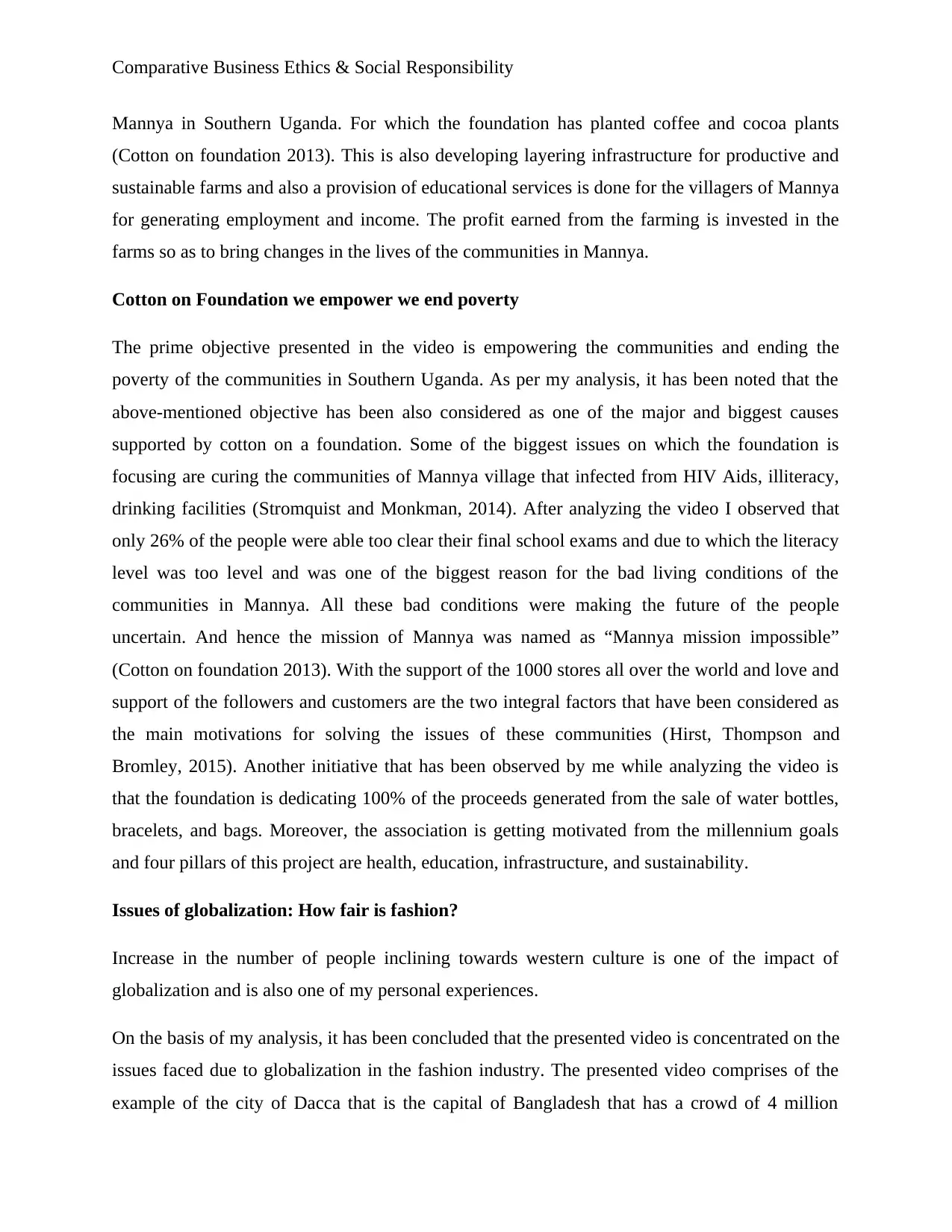
Comparative Business Ethics & Social Responsibility
Mannya in Southern Uganda. For which the foundation has planted coffee and cocoa plants
(Cotton on foundation 2013). This is also developing layering infrastructure for productive and
sustainable farms and also a provision of educational services is done for the villagers of Mannya
for generating employment and income. The profit earned from the farming is invested in the
farms so as to bring changes in the lives of the communities in Mannya.
Cotton on Foundation we empower we end poverty
The prime objective presented in the video is empowering the communities and ending the
poverty of the communities in Southern Uganda. As per my analysis, it has been noted that the
above-mentioned objective has been also considered as one of the major and biggest causes
supported by cotton on a foundation. Some of the biggest issues on which the foundation is
focusing are curing the communities of Mannya village that infected from HIV Aids, illiteracy,
drinking facilities (Stromquist and Monkman, 2014). After analyzing the video I observed that
only 26% of the people were able too clear their final school exams and due to which the literacy
level was too level and was one of the biggest reason for the bad living conditions of the
communities in Mannya. All these bad conditions were making the future of the people
uncertain. And hence the mission of Mannya was named as “Mannya mission impossible”
(Cotton on foundation 2013). With the support of the 1000 stores all over the world and love and
support of the followers and customers are the two integral factors that have been considered as
the main motivations for solving the issues of these communities (Hirst, Thompson and
Bromley, 2015). Another initiative that has been observed by me while analyzing the video is
that the foundation is dedicating 100% of the proceeds generated from the sale of water bottles,
bracelets, and bags. Moreover, the association is getting motivated from the millennium goals
and four pillars of this project are health, education, infrastructure, and sustainability.
Issues of globalization: How fair is fashion?
Increase in the number of people inclining towards western culture is one of the impact of
globalization and is also one of my personal experiences.
On the basis of my analysis, it has been concluded that the presented video is concentrated on the
issues faced due to globalization in the fashion industry. The presented video comprises of the
example of the city of Dacca that is the capital of Bangladesh that has a crowd of 4 million
Mannya in Southern Uganda. For which the foundation has planted coffee and cocoa plants
(Cotton on foundation 2013). This is also developing layering infrastructure for productive and
sustainable farms and also a provision of educational services is done for the villagers of Mannya
for generating employment and income. The profit earned from the farming is invested in the
farms so as to bring changes in the lives of the communities in Mannya.
Cotton on Foundation we empower we end poverty
The prime objective presented in the video is empowering the communities and ending the
poverty of the communities in Southern Uganda. As per my analysis, it has been noted that the
above-mentioned objective has been also considered as one of the major and biggest causes
supported by cotton on a foundation. Some of the biggest issues on which the foundation is
focusing are curing the communities of Mannya village that infected from HIV Aids, illiteracy,
drinking facilities (Stromquist and Monkman, 2014). After analyzing the video I observed that
only 26% of the people were able too clear their final school exams and due to which the literacy
level was too level and was one of the biggest reason for the bad living conditions of the
communities in Mannya. All these bad conditions were making the future of the people
uncertain. And hence the mission of Mannya was named as “Mannya mission impossible”
(Cotton on foundation 2013). With the support of the 1000 stores all over the world and love and
support of the followers and customers are the two integral factors that have been considered as
the main motivations for solving the issues of these communities (Hirst, Thompson and
Bromley, 2015). Another initiative that has been observed by me while analyzing the video is
that the foundation is dedicating 100% of the proceeds generated from the sale of water bottles,
bracelets, and bags. Moreover, the association is getting motivated from the millennium goals
and four pillars of this project are health, education, infrastructure, and sustainability.
Issues of globalization: How fair is fashion?
Increase in the number of people inclining towards western culture is one of the impact of
globalization and is also one of my personal experiences.
On the basis of my analysis, it has been concluded that the presented video is concentrated on the
issues faced due to globalization in the fashion industry. The presented video comprises of the
example of the city of Dacca that is the capital of Bangladesh that has a crowd of 4 million
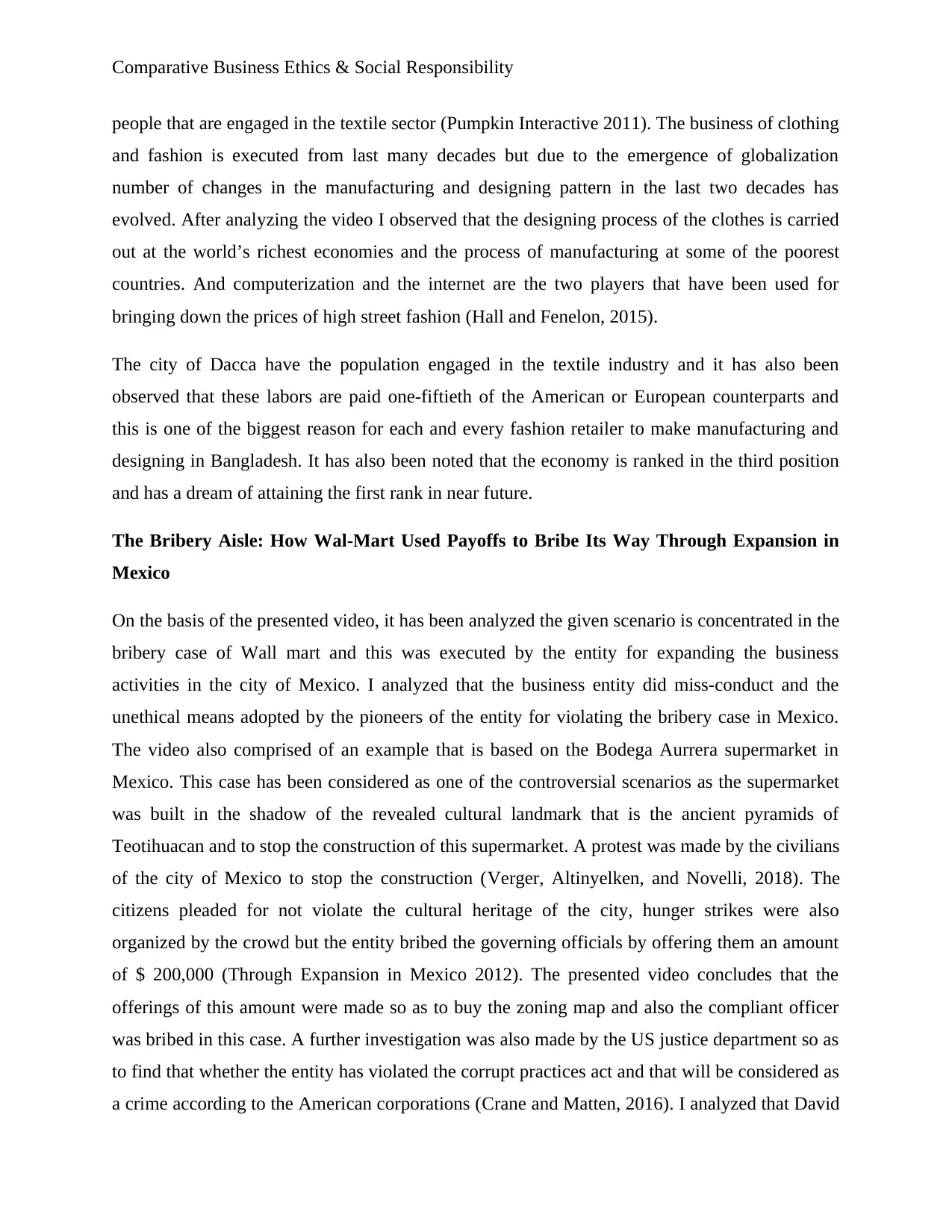
Comparative Business Ethics & Social Responsibility
people that are engaged in the textile sector (Pumpkin Interactive 2011). The business of clothing
and fashion is executed from last many decades but due to the emergence of globalization
number of changes in the manufacturing and designing pattern in the last two decades has
evolved. After analyzing the video I observed that the designing process of the clothes is carried
out at the world’s richest economies and the process of manufacturing at some of the poorest
countries. And computerization and the internet are the two players that have been used for
bringing down the prices of high street fashion (Hall and Fenelon, 2015).
The city of Dacca have the population engaged in the textile industry and it has also been
observed that these labors are paid one-fiftieth of the American or European counterparts and
this is one of the biggest reason for each and every fashion retailer to make manufacturing and
designing in Bangladesh. It has also been noted that the economy is ranked in the third position
and has a dream of attaining the first rank in near future.
The Bribery Aisle: How Wal-Mart Used Payoffs to Bribe Its Way Through Expansion in
Mexico
On the basis of the presented video, it has been analyzed the given scenario is concentrated in the
bribery case of Wall mart and this was executed by the entity for expanding the business
activities in the city of Mexico. I analyzed that the business entity did miss-conduct and the
unethical means adopted by the pioneers of the entity for violating the bribery case in Mexico.
The video also comprised of an example that is based on the Bodega Aurrera supermarket in
Mexico. This case has been considered as one of the controversial scenarios as the supermarket
was built in the shadow of the revealed cultural landmark that is the ancient pyramids of
Teotihuacan and to stop the construction of this supermarket. A protest was made by the civilians
of the city of Mexico to stop the construction (Verger, Altinyelken, and Novelli, 2018). The
citizens pleaded for not violate the cultural heritage of the city, hunger strikes were also
organized by the crowd but the entity bribed the governing officials by offering them an amount
of $ 200,000 (Through Expansion in Mexico 2012). The presented video concludes that the
offerings of this amount were made so as to buy the zoning map and also the compliant officer
was bribed in this case. A further investigation was also made by the US justice department so as
to find that whether the entity has violated the corrupt practices act and that will be considered as
a crime according to the American corporations (Crane and Matten, 2016). I analyzed that David
people that are engaged in the textile sector (Pumpkin Interactive 2011). The business of clothing
and fashion is executed from last many decades but due to the emergence of globalization
number of changes in the manufacturing and designing pattern in the last two decades has
evolved. After analyzing the video I observed that the designing process of the clothes is carried
out at the world’s richest economies and the process of manufacturing at some of the poorest
countries. And computerization and the internet are the two players that have been used for
bringing down the prices of high street fashion (Hall and Fenelon, 2015).
The city of Dacca have the population engaged in the textile industry and it has also been
observed that these labors are paid one-fiftieth of the American or European counterparts and
this is one of the biggest reason for each and every fashion retailer to make manufacturing and
designing in Bangladesh. It has also been noted that the economy is ranked in the third position
and has a dream of attaining the first rank in near future.
The Bribery Aisle: How Wal-Mart Used Payoffs to Bribe Its Way Through Expansion in
Mexico
On the basis of the presented video, it has been analyzed the given scenario is concentrated in the
bribery case of Wall mart and this was executed by the entity for expanding the business
activities in the city of Mexico. I analyzed that the business entity did miss-conduct and the
unethical means adopted by the pioneers of the entity for violating the bribery case in Mexico.
The video also comprised of an example that is based on the Bodega Aurrera supermarket in
Mexico. This case has been considered as one of the controversial scenarios as the supermarket
was built in the shadow of the revealed cultural landmark that is the ancient pyramids of
Teotihuacan and to stop the construction of this supermarket. A protest was made by the civilians
of the city of Mexico to stop the construction (Verger, Altinyelken, and Novelli, 2018). The
citizens pleaded for not violate the cultural heritage of the city, hunger strikes were also
organized by the crowd but the entity bribed the governing officials by offering them an amount
of $ 200,000 (Through Expansion in Mexico 2012). The presented video concludes that the
offerings of this amount were made so as to buy the zoning map and also the compliant officer
was bribed in this case. A further investigation was also made by the US justice department so as
to find that whether the entity has violated the corrupt practices act and that will be considered as
a crime according to the American corporations (Crane and Matten, 2016). I analyzed that David
Paraphrase This Document
Need a fresh take? Get an instant paraphrase of this document with our AI Paraphraser
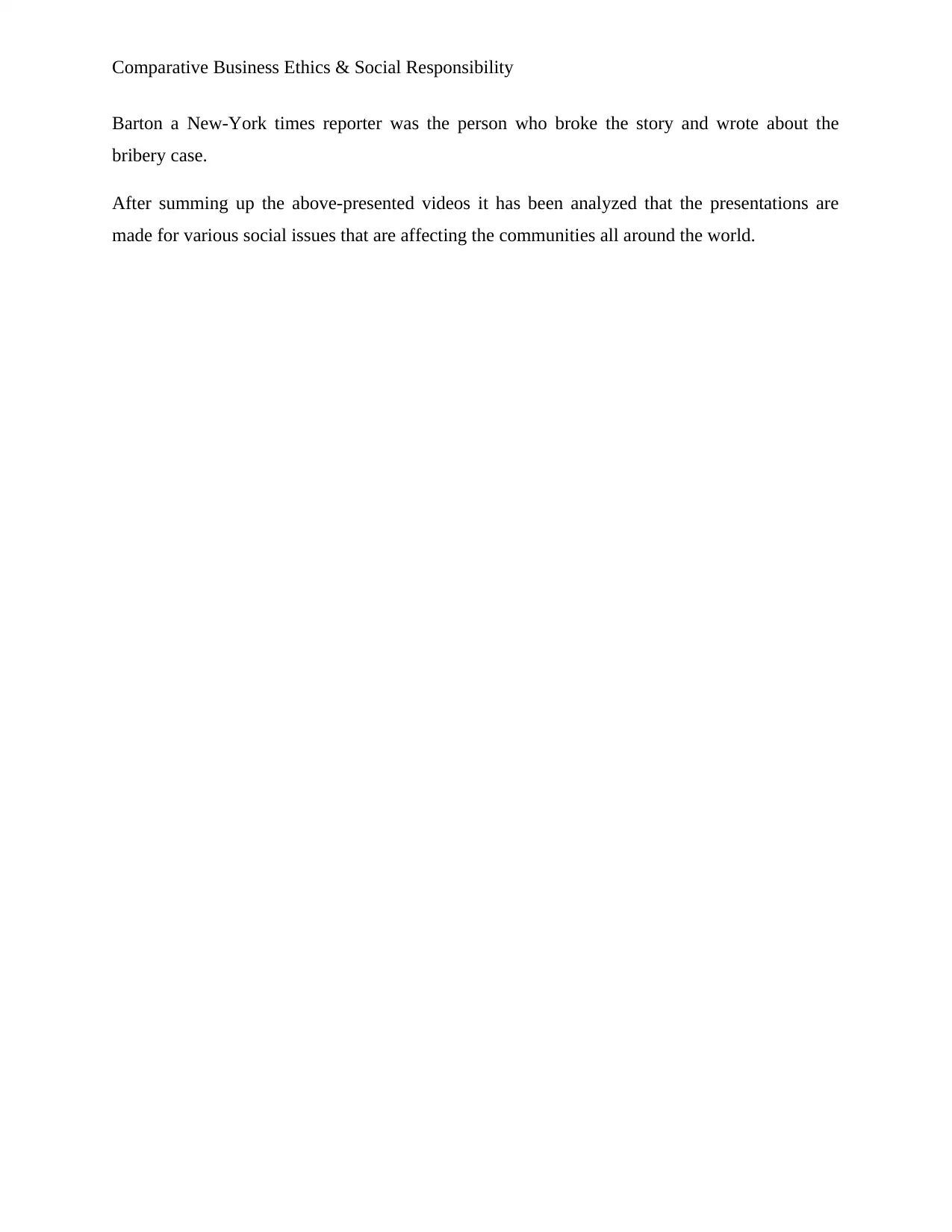
Comparative Business Ethics & Social Responsibility
Barton a New-York times reporter was the person who broke the story and wrote about the
bribery case.
After summing up the above-presented videos it has been analyzed that the presentations are
made for various social issues that are affecting the communities all around the world.
Barton a New-York times reporter was the person who broke the story and wrote about the
bribery case.
After summing up the above-presented videos it has been analyzed that the presentations are
made for various social issues that are affecting the communities all around the world.
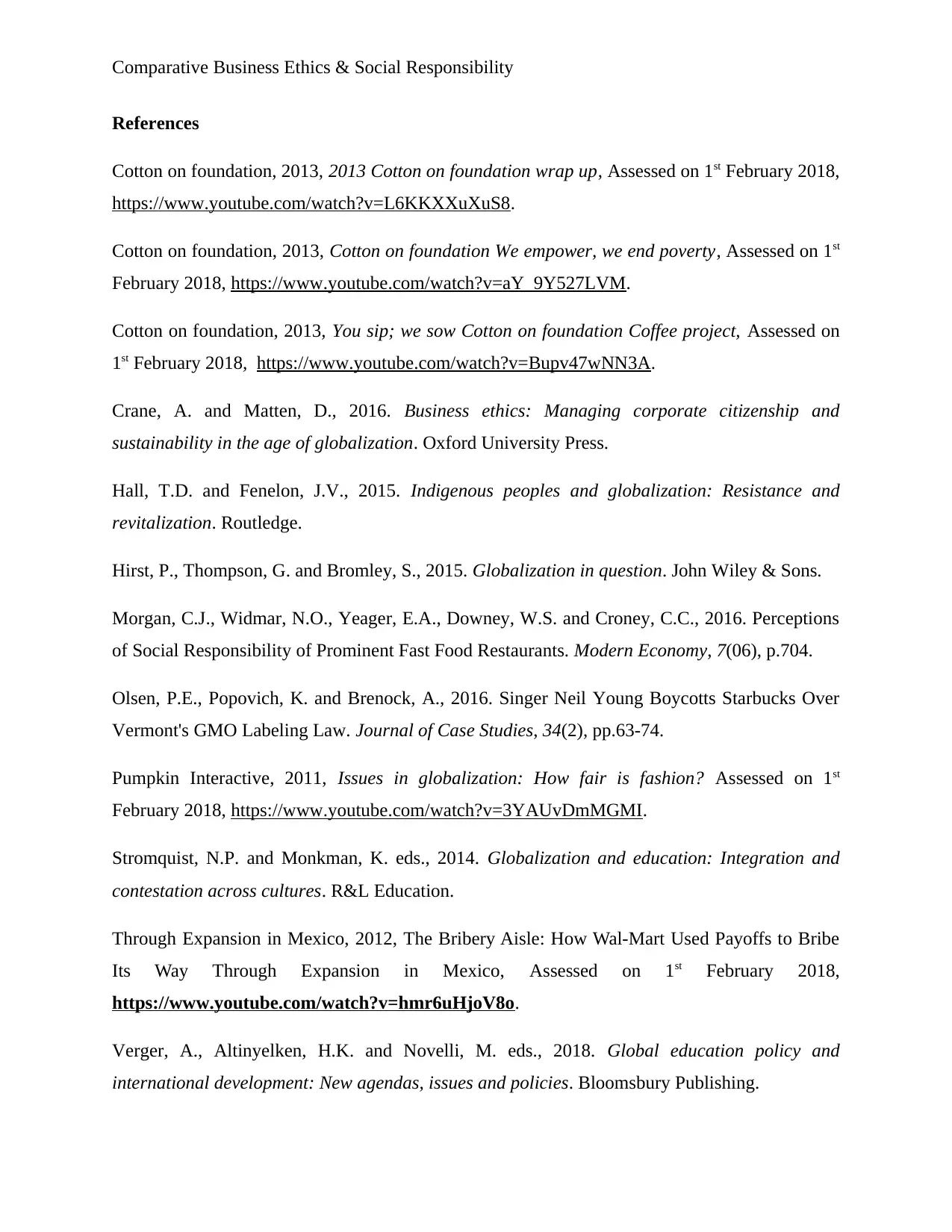
Comparative Business Ethics & Social Responsibility
References
Cotton on foundation, 2013, 2013 Cotton on foundation wrap up, Assessed on 1st February 2018,
https://www.youtube.com/watch?v=L6KKXXuXuS8.
Cotton on foundation, 2013, Cotton on foundation We empower, we end poverty, Assessed on 1st
February 2018, https://www.youtube.com/watch?v=aY_9Y527LVM.
Cotton on foundation, 2013, You sip; we sow Cotton on foundation Coffee project, Assessed on
1st February 2018, https://www.youtube.com/watch?v=Bupv47wNN3A.
Crane, A. and Matten, D., 2016. Business ethics: Managing corporate citizenship and
sustainability in the age of globalization. Oxford University Press.
Hall, T.D. and Fenelon, J.V., 2015. Indigenous peoples and globalization: Resistance and
revitalization. Routledge.
Hirst, P., Thompson, G. and Bromley, S., 2015. Globalization in question. John Wiley & Sons.
Morgan, C.J., Widmar, N.O., Yeager, E.A., Downey, W.S. and Croney, C.C., 2016. Perceptions
of Social Responsibility of Prominent Fast Food Restaurants. Modern Economy, 7(06), p.704.
Olsen, P.E., Popovich, K. and Brenock, A., 2016. Singer Neil Young Boycotts Starbucks Over
Vermont's GMO Labeling Law. Journal of Case Studies, 34(2), pp.63-74.
Pumpkin Interactive, 2011, Issues in globalization: How fair is fashion? Assessed on 1st
February 2018, https://www.youtube.com/watch?v=3YAUvDmMGMI.
Stromquist, N.P. and Monkman, K. eds., 2014. Globalization and education: Integration and
contestation across cultures. R&L Education.
Through Expansion in Mexico, 2012, The Bribery Aisle: How Wal-Mart Used Payoffs to Bribe
Its Way Through Expansion in Mexico, Assessed on 1st February 2018,
https://www.youtube.com/watch?v=hmr6uHjoV8o.
Verger, A., Altinyelken, H.K. and Novelli, M. eds., 2018. Global education policy and
international development: New agendas, issues and policies. Bloomsbury Publishing.
References
Cotton on foundation, 2013, 2013 Cotton on foundation wrap up, Assessed on 1st February 2018,
https://www.youtube.com/watch?v=L6KKXXuXuS8.
Cotton on foundation, 2013, Cotton on foundation We empower, we end poverty, Assessed on 1st
February 2018, https://www.youtube.com/watch?v=aY_9Y527LVM.
Cotton on foundation, 2013, You sip; we sow Cotton on foundation Coffee project, Assessed on
1st February 2018, https://www.youtube.com/watch?v=Bupv47wNN3A.
Crane, A. and Matten, D., 2016. Business ethics: Managing corporate citizenship and
sustainability in the age of globalization. Oxford University Press.
Hall, T.D. and Fenelon, J.V., 2015. Indigenous peoples and globalization: Resistance and
revitalization. Routledge.
Hirst, P., Thompson, G. and Bromley, S., 2015. Globalization in question. John Wiley & Sons.
Morgan, C.J., Widmar, N.O., Yeager, E.A., Downey, W.S. and Croney, C.C., 2016. Perceptions
of Social Responsibility of Prominent Fast Food Restaurants. Modern Economy, 7(06), p.704.
Olsen, P.E., Popovich, K. and Brenock, A., 2016. Singer Neil Young Boycotts Starbucks Over
Vermont's GMO Labeling Law. Journal of Case Studies, 34(2), pp.63-74.
Pumpkin Interactive, 2011, Issues in globalization: How fair is fashion? Assessed on 1st
February 2018, https://www.youtube.com/watch?v=3YAUvDmMGMI.
Stromquist, N.P. and Monkman, K. eds., 2014. Globalization and education: Integration and
contestation across cultures. R&L Education.
Through Expansion in Mexico, 2012, The Bribery Aisle: How Wal-Mart Used Payoffs to Bribe
Its Way Through Expansion in Mexico, Assessed on 1st February 2018,
https://www.youtube.com/watch?v=hmr6uHjoV8o.
Verger, A., Altinyelken, H.K. and Novelli, M. eds., 2018. Global education policy and
international development: New agendas, issues and policies. Bloomsbury Publishing.
1 out of 6
Your All-in-One AI-Powered Toolkit for Academic Success.
+13062052269
info@desklib.com
Available 24*7 on WhatsApp / Email
![[object Object]](/_next/static/media/star-bottom.7253800d.svg)
Unlock your academic potential
© 2024 | Zucol Services PVT LTD | All rights reserved.


